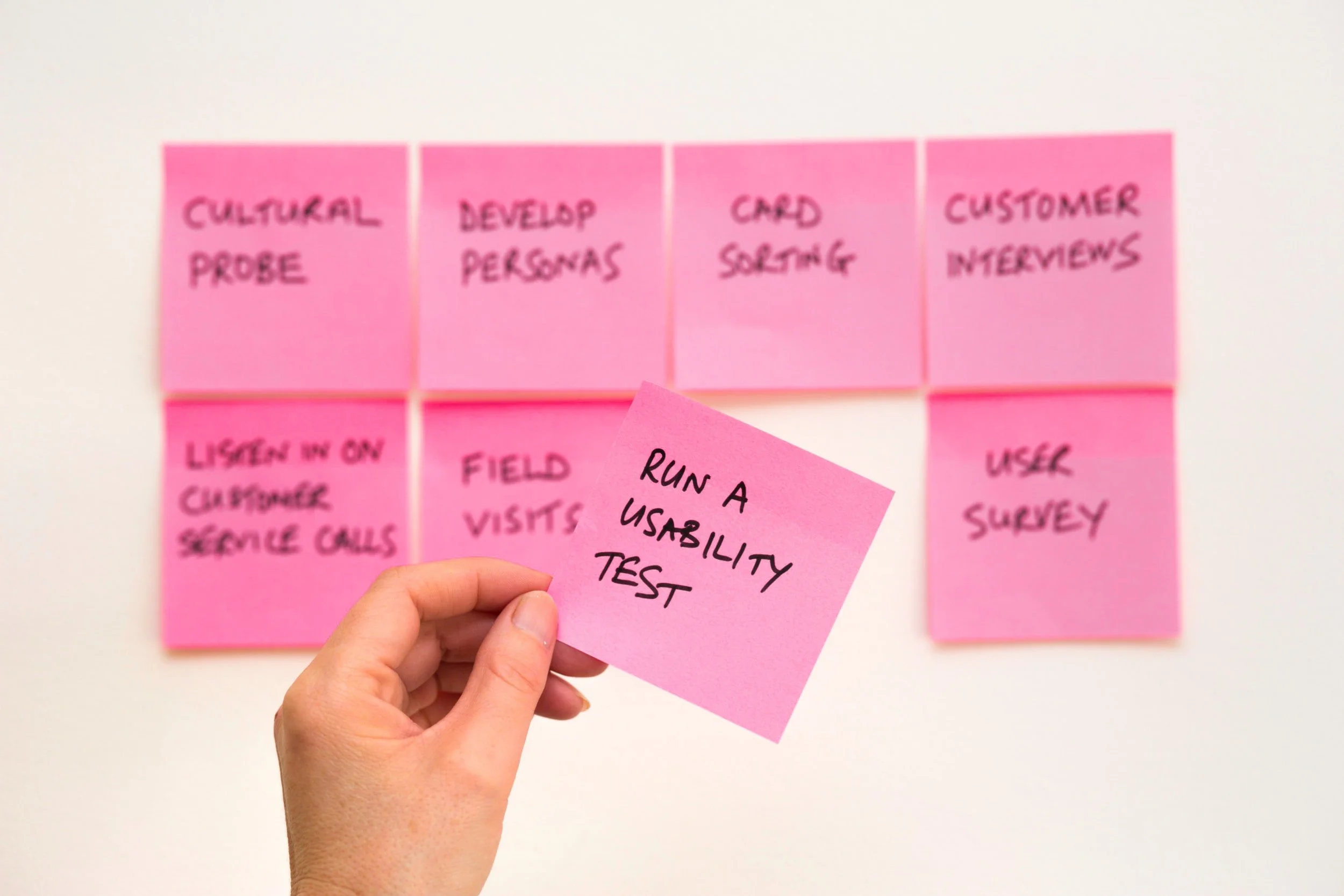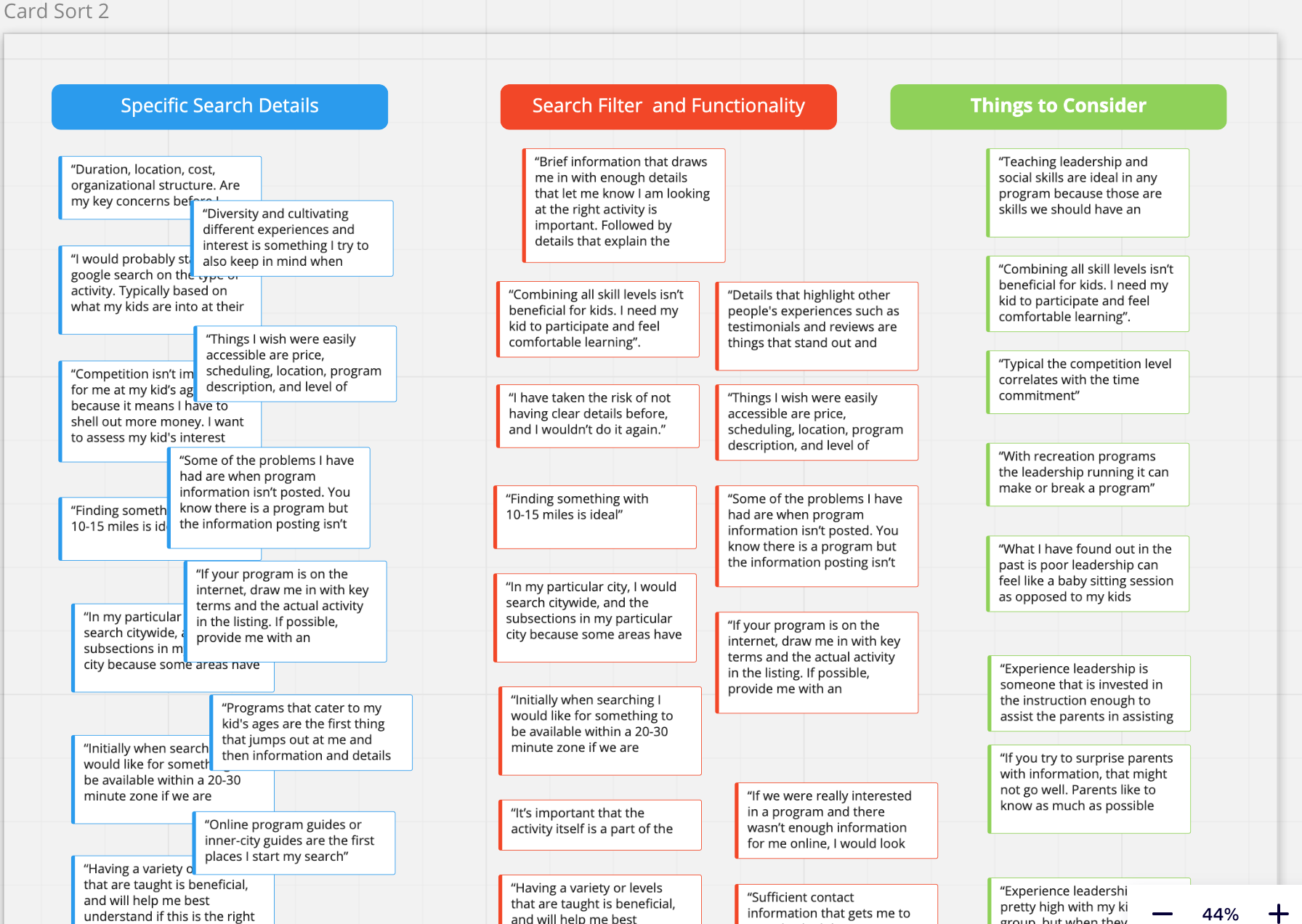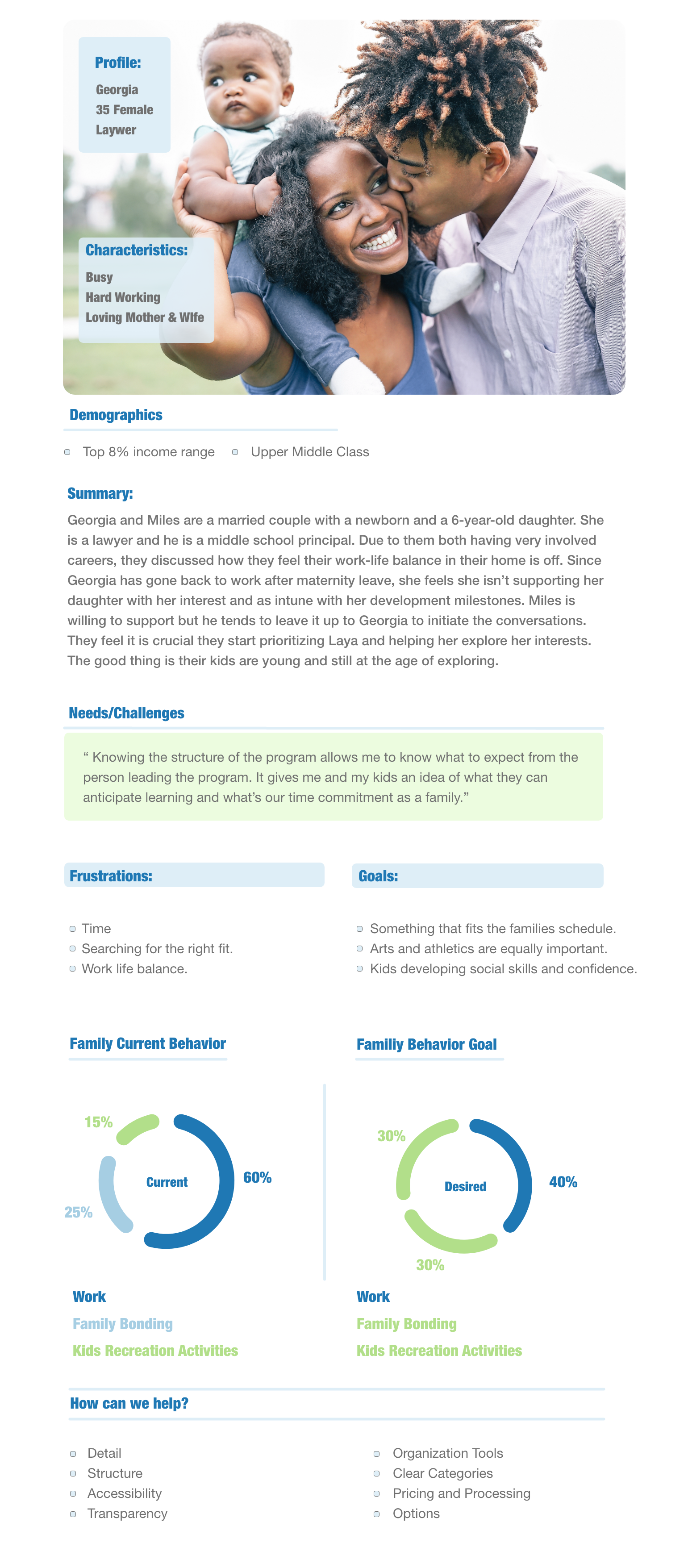
Recreational Program Information Channel and Systems Analysis
Executive Summary
There is no specific application or listing for local recreation programming nationwide. Our focus for this research is to understand how parents search and find recreation programs locally and what problems they face trying to find the right programs.
On a broader scale, these programs help our children build trust and improve social skills, but at the current rate of decline, many kids are losing opportunities to increase self-esteem and improve problem-solving skills.
70% of kids quit recreational sports in the United States by age 13. Much of this has to do with the growing competitive nature of sports as kids get older. Many of these competitive programs are amazing but there need to be accessible options that assist in balancing between competition, and fun exercise. Many of our kids’ lives are surrounded by electronics which can promote sedentary lifestyles but having accessibility options gives them the opportunity to participate in high-calorie burning activities that are fun without demoralizing children who are as competitive.
70%
Non-participants by age 13
Methodology
For this study, we’re using “Qualitative Testing” where we will conduct various Zoom video call interviews to test product usability, semi-structural interviews, contextual inquiries, and user card sorting activities.
These methods will enable us to gain a deeper understanding of our customer's needs, empathize with their concerns, and better understand our objectives.
Usability Test - Competitive Analysis
Semi-Structural Interviews
Contextual Inquiries
Card Sorting
Thematic Diagrams
Participants
Psycho-Demographics
Parents who are between the age of 25-50
Kids 2-16
Various social-economic backgrounds.
Male/Female mix

Participants
-

Grocer
Mother
Age: 38
Female
-

Engineer
Father
Age: 44
Male
-

Accountant
Father
Age: 49
Male
-

Marketing
Father
Age: 34
Male
We’re using “Qualitative Testing” for this study, where we will conduct 30-45 -minute Zoom video call interviews, testing the user's responses and activities while searching a local municipal website for recreational programs.
Success Steps:
Community Tab
Digital Activity Guide
Registration Link
Scroll down to see listings
Select a sport or activity
Review options and select interest
Sign Up
Registration Steps
Graded Steps
User’s who pressed the “Community Link”
User’s Who navigated to “Registration”
User’s who successfully selected a activity
User who completed signed up process
User’s who found “Digital Activity Guide”
User who scrolled down to see listing
Users who reviewed specific activity descriptions.
System Usability Scale
-

Grocer
SUS Score 70
Good
PASS
-

Engineer
SUS Score 72.5
Good
FAIL
-

Accountant
SUS Score 7.5
Awful
FAIL
-

Marketing
SUS Score 60
Poor
FAIL
Key Insights
1 out of 4 users finished the process end to end.
3 out of 4 users felt the listing wasn’t clear or organized.
0 out of 4 users actually used the search filter or even found it.
City municipal websites have a lot of information to cover. Typically how information is organized comes down to the local government's funding as well as the recreation department’s organization.
Implementing tools can often be based on what the software can and should do, and not how it integrates with all the other information on the local government's website.
We found that users will get distracted if the navigation isn’t extremely clear and geared towards carefully guiding the user from beginning to end.
This method enabled us to gain a deeper understanding of our customer's needs, empathize with their concerns, and gained a greater understanding of our objectives and goals.

Semi Structural Interviews
Interview Approach
Our “Semi Structural Interviews” were designed to ask users: what is their typical process for searching and identifying problems, and what are some of the pain points they might have along the journey of identifying the right fit for their family?
Each video was recorded and analyzed.
Quotes were extracted based on:
pain points
user needs
possible concerns
additional things for consideration
Sample Quotes
“I would probably start with a google search on the type of activity. Typically based on what my kids are into at their age like arts and crafts, or swimming programs.”
“Duration, location, cost, organizational structure. Are my key concerns before I begin my search”
“Having a variety of levels that are taught is beneficial, and will help me best understand if this is the right program for my kid.”
KEY FINDINGS
These semi-structural interviews turned out to be crucial qualitative data for the overall case study. There was a lot of key data that allowed us to quantify potential approaches for building an application. It also gave us a clear understanding of how to organize and solve some of the pain points for the user.

Contextual Inquiries | Card Sorts
Card Sorts Exercise
Semi-structural interview data was extracted into quotes, which were used in a card sorting exercise.
Participants were asked to match the quotes under the objective that best match their process.
Key Learnings
This card sorting method allowed us to align real user qualitative data with our objectives.
It gave us insights and leads we could quantify into an application.

Thematic Analysis
Analysis Method
Interview quotes are drilled down into 3 main processes and given category codes.
SSD
Specific Search Details
SFF
Search Filter and Functionality
TTC
Things to Consider
Key Learnings
This Thematic Analysis method helped us isolate clear concerns around functionality which will assist our product design.
Empathy Map
-

What they think and feel?
“Diversity and cultivating different experiences and interest is something I try to also keep in mind when searching”
-

What they say and do?
“I have taken the risk of not having clear details before, and I wouldn’t do it again.”
-

What do they hear?
“Details that highlight other people's experiences such as testimonials and reviews are things that stand out and help me access what other parents and kids have experienced.”
-

What do they see?
“Typical the competition level correlates with the time commitment”

User Personas

Journey Map/Experience Map

How might we?
HMW?
How might we create a search filter base on users' key search concerns and interests?
How might we separate competition and skill levels?
How might we present the program title and program summary to users?
How might we make contact details accessible to users?
How might we present the information based on specific search inquiries?
How might we present cost and payment details to users?
How might we display the program's services and information to users?
How might we design a calendar system for users?
How might we organize and process payments for users?
How might we allow users to review and rate programs?
How might we create an announce system?
How might we give the user the ability to share information with peers?

What’s next?
The how might we statements should assist the product development team with the following areas.
Defining the Minimum Viable Products (MVP)
Paper prototyping
Wireframing
Usability testing of the prototypes
This research was primarily focused on the parent as the end-users.
More qualitative data is needed from lower social economic and lower-middle-class participants due to limited data from this demographic.
Another iteration of research can be done on programs that will populate the application exploring additional pain points and needs.
Data has been summarized for presentation purposes, but additional details can be provided in PDF format upon request.













